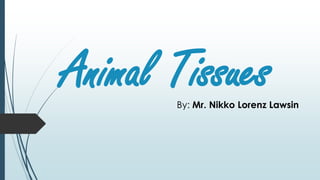
Lesson 11 animal tissues
- 1. Animal TissuesBy: Mr. Nikko Lorenz Lawsin
- 2. TissueGroup of cells that performs unified functions. Epithelial Tissues Connective and Supportive Tissues Vascular Tissues Muscular Tissue Nervous Tissues
- 3. Epithelial Tissue •For protection. •Simple vs. Stratified (name of the strata depends on the topmost layer.
- 4. Simple Squamous • Covering of the blood vessels
- 5. Simple Columnar • Lining of the digestive tract
- 9. 9
- 10. 10
- 11. 11
- 12. 12
- 13. • are modified epithelial tissues that perform secretions. According to Structure Glands UNICELLULAR GLANDS SAC-LIKE GLANDS TUBULAR GLANDS
- 14. • are modified epithelial tissues that perform secretions. According to Secretion Glands
- 15. Connective Tissue•Fewer cells and large amount of matrices (space). • connect one tissue to another and join organs which are attached to the backbone •Example: Ligaments (connects bone to bone) and tendons (connect muscle to bone)
- 16. Connective TissuesComponents: Fibers, Inorganic and Organic Substances FIBERS Inorganic substances Organic substances 1. Elastic Fibers (Yellow) – thin, straight and branching 2. Collagenous Fibers (White) – thick, wavy and non branching 3. Reticular Fibers – short and multi-branching. 1. Calcium Carbonate (CaCO3) 2. Calcium Phosphate Ca3(PO4)2 1. Collagen 2.Mucopolysaccharide (glycosaminoglycans)
- 17. Types of Connective Tissue 1. Elastic Connective Tissue found in ligaments (more elastic than tendon)
- 18. Types of Connective Tissue 2. Fibrous Connective Tissue wavy and made up of collagen. Ex: in tendon
- 19. Types of Connective Tissue 3. Reticular Connective Tissue - Network of reticular fibers that can be found in spleen, lymph nodes and bone marrow.
- 20. Types of Connective Tissue 4. Areolar Connective Tissue it has two fibers (thick collagenous & elastic fibers) -found in dermis of the skin and mesentery ex: Pericardial cavity
- 21. Types of Connective Tissue 5. Adipose Connective Tissue it is found on subcutaneous layer of skin; it also protects the mammary glands and storage of foods.
- 22. Supportive Tissue1. Cartilage – allows movements and keeps the tubes open at all times. 2. Bones – made up of Haversian System
- 23. Supportive TissueHyaline Cartilage Elastic Cartilage Fibrocartilage - has no fiber; purely chondrocytes - present in nose and fontanels of babies during embryonic and early stages. (weakest cartilage) - is a yellowish flexible cartilage made up of elastic fibers. - found in external ears, epiglottis and larynx. is found in intervertebral discs, joint capsules, ligaments.
- 26. Fibrocartilage
- 27. Bones Haversian system is composed of the following; 1. Haversian canal (central canal) contains blood vessels such as capillaries. 2. Haversian laminae (matrix) – gives protection 3. Osteocytes – bone cell which secretes materials like Calcium carbonate 4. Canaliculi (small canal) forms connections like nerves 5. Periosteum – membrane of bone cell which is designed for protection.
- 28. According to Shape Types of Bones
- 29. According to Consistency Types of Bones
- 30. Vascular Tissue Plasma – mainly fluid (composed of 90-95% water) and others are organic and inorganic compounds. Its main function is to transport materials throughout the body.
- 31. Vascular Tissues Blood - generally transport materials in the body. It is a liquid tissue because it is composed of different cells like Red blood cells (RBC)/Erythrocyte, White Blood cells (WBC)/Leukocytes and Blood platelets (Thrombocytes). It has large amount of water (H2 O), making it as fluid. It also contains organic compound like sugar (dextrose, liquid form of glucose) and proteins Lymph - for drainage, replaces whatever less from the blood/circulatory system, and for building immune system and resistant to diseases.
- 33. Albumin binds water, cations (such as Ca2+, Na+ and K+), fatty acids, and hormones. It also regulates the colloidal osmotic pressure of blood. Fibrinogen for blood clotting and blood coagulation. It is transformed into fibrin Globulin (Alpha and beta globulin – maintains viscosity of the blood while Gamma or Immunoglobulin (Ig’s) for immune system. Component of Plasma
- 34. Red Blood cell- Looses it nucleus upon maturity resulting to biconcave-shaped. Its shape provides larger surface are for binding oxygen from environment and transport it to body tissues. - It contains Hemoglobin, an iron-containing protein which makes blood red in color. - Reticulocytes are immature erythrocytes
- 35. White blood cell
- 36. Mechanisms of Immune System
- 37. Mechanisms of Immune System
- 38. Muscular TissueMain Function: for contraction leads to locomotion. 1. Excitability – capacity to receive and response to a stimulus. 2. Contractility – the ability to contract or shorten 3. Extensibility – ability to stretch. 4. Elasticity – ability to return to its original shape after being stretched or contracted.
- 39. Types of Muscles
- 41. Nervous Tissues
- 42. Nervous Tissues
- 43. Kinds of Neurons Sensory / Afferent Neuron – transmit impulses from receptors (parts that receive stimuli) to Central Nervous System (CNS). Associating / Interneuron – transmits impulses from sensory to motor neurons (within CNS) Motor / Efferent Neuron – transmits impulses from CNS to effectors (parts that exhibits response or reaction to stimuli).
- 44. Kinds of Nerve FibersMyelinated – covered with myelin sheath, an adipose tissue which protects nerve fibers. Non-myelinated – does not covered by myelin sheath
- 45. Gray Matter – non myelinated (important in decision making) White Matter – myelinated (important in immediate response) Reflexes that require immediate response is processed in spinal cord.
- 47. Types of Neural Circuit
- 48. 1.Convergent – impulses coming from different sources moves in the same neurons
- 49. 2. Divergent – impulses moves either in the same or multiple pathways in transmitted in different neurons.
- 50. 3. Oscillation/Reverberation – it is the circumnavigation of impulses among neurons.
- 51. 4. Parallel after-discharge – consists both of convergent and divergent circuit. It involves during complex mental processes.
